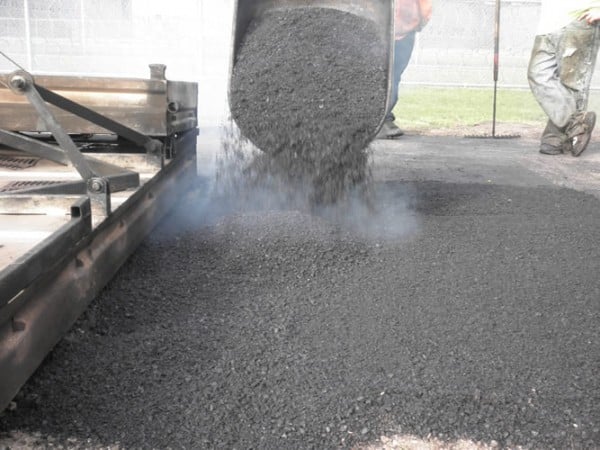Hot Mix Asphalt Paving: Your Entrance to Premium Angled Parking Solutions
Wiki Article
Unlocking the Secrets of Hot Mix Asphalt Technology
Checking out the midsts of hot mix asphalt innovation reveals a globe where precise formulations and meticulous processes converge to shape our roads and infrastructure. The fusion of binders, accumulations, and fillers isn't simply a building task but a tactical orchestration of sturdiness and effectiveness. As we peer into the intricate dance of parts, a tapestry of strength and sustainability unravels. Yet what exists underneath this surface of asphaltic mastery, and what keys wait to be introduced in the realm of paving innovations?Importance of Hot Mix Asphalt
Hot Mix Asphalt plays a crucial function in contemporary framework advancement because of its sturdiness and cost-effectiveness. As one of the most typically made use of paving product for roads, highways, and parking area, Warm Mix Asphalt uses a series of benefits that add to its significance in building and construction projects. One crucial benefit is its ability to stand up to hefty traffic lots and severe weather, offering a trustworthy and long-lasting surface for transport networks. In Addition, Hot Mix Asphalt is affordable in both first building and construction and long-term maintenance, making it a favored option for several infrastructure projects.The longevity of Warm Mix Asphalt stems from its make-up, which includes aggregates, binder, and filler products that are very carefully selected and blended to satisfy particular efficiency demands. Overall, the relevance of Hot Mix Asphalt in infrastructure advancement can not be underrated, as it proceeds to be a cornerstone of modern-day building practices.
Parts of Asphalt Mixes
The composition of asphalt blends consists of meticulously selected accumulations, binder, and filler products that are crucial for accomplishing details performance requirements. Aggregates are the main part of asphalt mixes, giving stamina and security. These accumulations can be all-natural, such as gravel or crushed rock, or artificial, like recycled materials from old sidewalks. The binder, usually asphalt or asphalt cement, holds the accumulations with each other and offers versatility and longevity to the mix. The selection of the binder is vital as it directly influences the mix's efficiency in various weather. Fillers, such as moisturized lime or Rose city cement, are utilized to boost the mix's workability and aging resistance. Angled Parking.The mix and percentage of these parts play a substantial role in determining the top quality and performance of the asphalt mix. Engineers thoroughly develop the mix to satisfy particular demands, thinking about aspects like web traffic volume, environment problems, and pavement life expectancy. Appropriate selection and balancing of aggregates, binder, and fillers are essential for creating durable, long-lasting asphalt sidewalks.
Combining and Manufacturing Strategies

As soon as the accumulations are picked, the binder, often asphalt cement, is included in bind the materials with each other. The binder's quality and amount significantly affect the mix's stamina, versatility, and resistance to environmental elements. Additionally, fillers like hydrated lime or Rose city concrete might be integrated to improve particular attributes of the asphalt mix, such as its workability or wetness resistance.
During manufacturing, the accumulations and binder are heated up, normally in between 250-325 ° F(121-163 ° C ), to help with mixing and make sure appropriate finishing of the aggregates. The blending procedure should be extensive to achieve an uniform blend that promotes the wanted efficiency features of the asphalt. discover this Different techniques, such as set mixing or drum mixing, are used to accomplish consistent and high-grade asphalt mixes for building and construction jobs.
Elements Influencing Asphalt Performance
Elements affecting asphalt efficiency encompass a variety of variables that influence the sturdiness, longevity, and general top quality of asphalt pavements. One crucial variable is the quality of materials utilized in the asphalt mix.
Environmental problems likewise affect asphalt performance. Temperature variants, moisture seepage, and traffic tons can all impact the structural honesty of the pavement. Style considerations, such as pavement density and drainage, are important in making certain the long-term efficiency of the asphalt sidewalk. By thoroughly taking into consideration these aspects, service providers and engineers can enhance asphalt efficiency and boost the life span of pavements.
Lasting Practices in Asphalt Innovation

WMA enables for the manufacturing and placement of asphalt blends at reduced temperatures contrasted to conventional hot-mix asphalt, resulting in lowered energy usage and greenhouse gas emissions. The use of permeable asphalt blends can help alleviate stormwater runoff problems by permitting water to infiltrate with the sidewalk and right into the ground, promoting all-natural water purification and recharge processes.
Verdict
In verdict, hot mix asphalt technology plays a vital duty in modern-day infrastructure development because of its toughness and cost-effectiveness. By thoroughly balancing elements, utilizing appropriate mixing methods, and thinking about different aspects, engineers can produce top notch asphalt blends that stand up to hefty website traffic tons and extreme weather. Accepting sustainable methods, such as utilizing warm-mix technologies and recycled materials, further boosts the ecological kindness of asphalt innovation.
Mixing and manufacturing strategies in hot mix asphalt technology involve the specific mix and handling of aggregates, binder, and fillers to develop a sturdy and high-performance asphalt mix.Elements influencing asphalt efficiency include a range of variables that influence the longevity, durability, and overall top quality of asphalt sidewalks. Sustainable techniques in asphalt innovation encompass numerous efforts aimed at minimizing the environmental influence of asphalt manufacturing and paving processes. By including reclaimed asphalt sidewalk (RAP) and recycled asphalt roof shingles (RAS) right into new asphalt blends, the industry can substantially minimize the intake of raw materials the original source and power, while likewise lowering garbage dump waste.
WMA permits for the production and positioning of asphalt mixes at reduced temperatures contrasted to traditional hot-mix asphalt, resulting in reduced power usage and greenhouse gas exhausts.
Report this wiki page